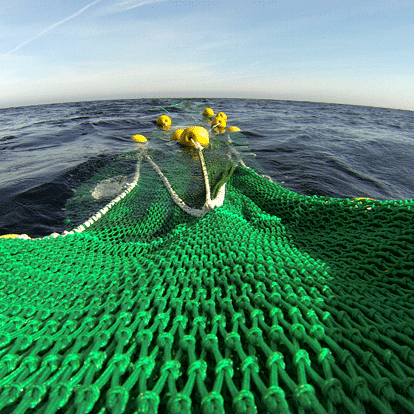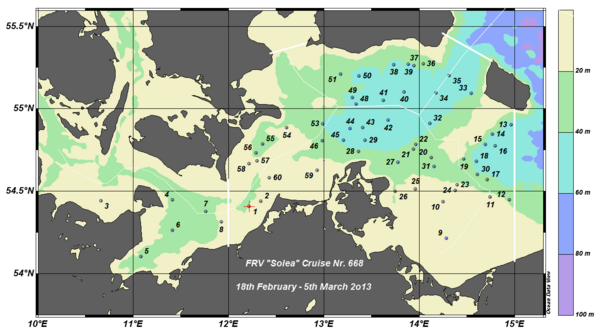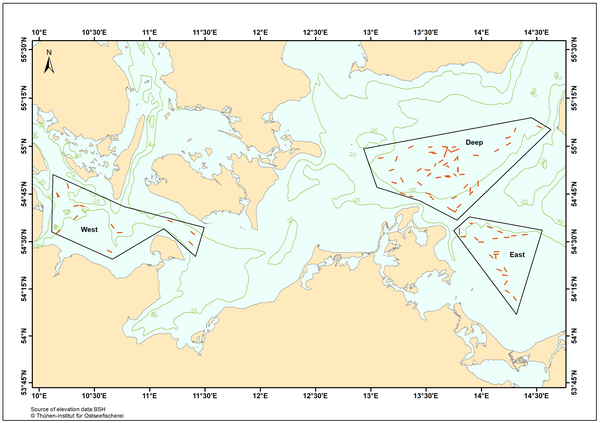Trawl Surveys
The abundance of bottom-dwelling fish species such as cod, whiting, flounder, plaice, dab or turbot can be determined by standardized bottom trawl catches.
For this purpose, catches of a defined duration are conducted at the same period each year using a standard net. From the catch results, it can be extrapolated how many fish of a species occur in an area and how this frequency changes across years. In addition, we collect biological data on individuval fish, such as age, maturity, nutritional status; and environmental data are collected using standard oceanographic methods. The Institute of Baltic Sea Fisheries currently conducts three different trawl surveys at different times of the year, all following the Baltic International Trawl Survey (BITS) procedure: 1) The BITS is conducted by all Baltic Sea states in February and November. 2) The Baltic Box Survey (BaltBox) is conducted in the western Baltic Sea. 3) The CoBalt trips investigate the ecology of Baltic cod.
Baltic International Trawl Survey (BITS)
The BITS provides the most important fishery-independent information on the status of the demersal fish species cod, flounder, plaice, dab, turbot and brill in the Baltic Sea. The cruise is conducted twice a year in the first and fourth quarter.
Germany has participated in these trips since 1978 (4th quarter) and 1981 (1st quarter), and twice a year since 1991 with FFS Solea, sampling the western Baltic Sea with approximately 120 stations annually (trip duration: 2 x 20 days). On different vessel, Denmark, Sweden, Estonia, Latvia, Lithuania, Russia, Poland and Germany simultaneously collect data on abundance and biological data (e.g. length, weight, sex, maturity and health status) of the commercially important demersal fish species. The cruises are coordinated by the International Council for the Exploration of the Sea (ICES) via the ICES Working Group on Baltic International Fisheries Surveys (WGBIFS). Stations to be sampled are randomly selected from a long list of known trawlable locations throughout the Baltic Sea. Environmental data such as water temperature, salinity and oxygen levels are regularly recorded and using international standard approach, information on marine litter is also collected. After the cruises, the data are are validated and uploaded to the international trawl survey database of ICES (DATRAS database). These fisheries biology data are part of the input data used by ICES to conduct the annual stock assessments and catch forecasting. The data are also valuable for the Marine Strategy Framework Directive. The European Union funds the cruises within the scope of the Data Collection Framework.
Ansprechpartner im Institut für Ostseefischerei und Fahrtleiter der aktuellen Reisen ist Dr. Andres Velasco.
Cod in the Baltic (CoBalt): Maturity and fecundity determination on cod
In this series of research cruises, the maturity and fecundity of cod of the western and eastern Baltic Sea has been determined since 1992 with FFS Solea and FK Clupea.
Since an external evaluation in 2009, these cruises also follow the BITS standard protocol, for which the frequency was reduced from 4 cruises per year to two to three cruises. They provide us with important information on changes in the fecundity and biological features of cod like body condition.
Contact person is Martina Bleil.
BaltBox: Survey of biodiversity and natural variability of the demersal fish fauna in the western Baltic Sea
Der Boxensurvey (BaltBox) dient dem langfristigen Monitoring der Biodiversität der demersalen Fischartengemeinschaft und der Erfassung ihrer natürlichen Variabilität vor der deutschen Ostseeküste.
Das Thünen-Institut für Ostseefischerei führt den rein nationalen Survey mit FFS Solea seit 2003 in festen Referenzgebieten (Boxen) durch (siehe Karte). Die Boxen befinden sich in für die Ostsee charakteristischen Gebieten von der Kieler und Mecklenburger Bucht über das Arkonabecken bis zur Oderbank. Die Beprobung erfolgt nach internationalem Standard (BITS), wobei die insgesamt 7 Boxen stets im Juni mit 70 festen Stationen beprobt werden (13 Tage Reisedauer). Es werden Daten zur Häufigkeit, Länge und Gewicht aller erfassten Arten erhoben sowie im Fall der wichtigsten kommerziellen Grundfisch-Arten (Dorsch und Plattfische) Daten zu Geschlecht, Reife und Gesundheitszustand. Auf jeder Station werden wichtige Hydrographiedaten zu Wassertemperatur, Salz- und Sauerstoffgehalt ermittelt. Zudem wird der beigefangene Müll im Rahmen des Fischereidaten-Erhebungsprogramms erfasst und dokumentiert.
Der BaltBox Survey soll eine Basis für das Erkennen und Bewerten von Eingriffsfolgen liefern bzw. dazu beitragen eventuelle Summationswirkungen aus der Vielzahl von Eingriffen bzw. klimatischen Veränderungen zu erfassen. Die westliche Ostsee stellt ein Übergangsgebiet zwischen dem marin geprägten Kattegatt und der eigentlichen Ostsee dar. Sie zeichnet sich durch eine thermohaline Schichtung, einen hohen Salzgehaltsgradienten von West nach Ost sowie eine hohe Dynamik der hydrographischen Parameter aus. Das Fischartenspektrum und die Verbreitung der einzelnen Arten werden stark durch diese natürlichen Phänomene bestimmt.
Von 2010 bis 2012 war der BaltBox-Survey Bestandteil des Fehmarn-Belt-Projektes und lieferte wichtige Daten für die zeitlich-räumliche Dynamik wichtiger kommerziell genutzter Fischarten. Seit 2013 ist der BaltBox-Survey im Rahmen der Meeresstrategie-Rahmenrichtlinie bei der EU als Survey zur langfristigen Erfassung der natürlichen Variabilität der demersalen Fischartengemeinschaft in der westlichen Ostsee gemeldet.
Ansprechpartner im Institut für Ostseefischerei und Fahrtleiter der aktuellen Reisen ist Dr. Daniel Oesterwind.

![[Translate to English:] [Translate to English:]](/media/_processed_/d/7/csm_Startseite-OF_03_c0dfd6e750.png)
![[Translate to English:] [Translate to English:]](/media/_processed_/a/3/csm_20181116-151457-Stella-Jerome-Fischfalle-Warnem%C3%BCnde-Dorsche-im-Netzk%C3%A4fig-5691_heller_3050c72fa2.png)



![[Translate to English:] Logo des Bundesministerium für Ernährung und Landwirtschaft](/media/allgemein/logos/BMEL_Logo.svg)